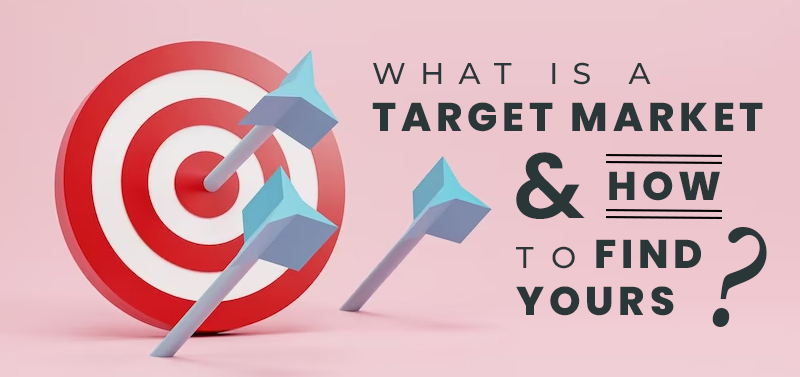February 21, 2023 9:57AM
What is a Target Market & How to Find Yours

When starting a new business or launching a new product to the market, one of the key tasks is to identify and develop a marketing plan around the target market of the business or product. This is an important step which can have a major impact on both the cost of marketing and also the effectiveness of the marketing campaigns. In order to ensure your products are being marketed to their best, there must be a clear and defined target audience.
In this article, we take a closer look at what defines a target market as well as share our top tips on how to identify and define the target market for your business.
What is a Target Market?
The target market of a business is a specific group or groups of people that businesses want to reach through their marketing efforts. These are people who are most likely to buy products from a business. A target market can consist of wide criteria for example; Males/Females of all age groups. Or it can be more defined for example; Male, aged 25-30, living within 10km of business.
When identifying your target market you will need to focus on what particular needs your product addresses for specific groups. The group with the highest need for your product will be your first priority. For example: If you are selling an energy drink, your target market would be consumers who are interested in sports and fitness. You may also identify other target markets which would be considered lower priority.
By doing this effectively you will have a better idea of which target market you should invest the most of your resources and budget targeting.
It's also important to remember that target markets often can change over time. As brands become more popular they can often open up new target markets or existing target markets can become wider in terms of factors such as age, gender, demographic etc.
What Defines a Target Market?
A target market can consist of many factors depending on the type of business/product. In general, when identifying a target market business will focus on the following:
Demographic
This includes variables such as age, gender, income, education level or size of household. Businesses may use this information to determine the consumer's spending habits or buying power. For example, a broadband internet company would have a target market for families, knowing that their products will in most cases be used by more than one person in the household.
Geographic
These target markets are defined by location. Town, State, City or even country are all variables used. Sometimes locations will also be selected based on the population size. For example, If a company is planning to use billboard advertising they may focus more heavily on traffic flow within that location in order to maximise the number of impressions on their advert.
Psychographic
This includes variables such as social class, lifestyle, and values. For example, a brand which sells luxury champagne may decide to target people from a higher social class due to the price point of their brand and also the higher likelihood that someone from an Upper-class background would purchase their product.
Behavioural
This refers to how consumers behave, such as how many times they use a specific product or how a product benefits them specifically or how likely they are to stick to a specific brand.
As mentioned earlier, a target market may include elements from all four of the above depending on the level of detail and amount of data available to hand.
How to Find Your Target Market
To find your target market, start by making a list of the characteristics that make up your ideal customer. Then go through this list and prioritise them based on how important they are to you—what's most important? What's least important?
- Age Group (High Importance)
- Gender (Less Importance)
- High Income (High Importance)
Once you've done this, rank each characteristic by how well it describes your ideal customer: if it describes them very well, then it's probably very important; if not, then maybe not so much.
Once you've made this list, look at it again with an eye toward cost: what will be most expensive (or difficult) for you to achieve? What will be easiest? Then prioritise those things according to their cost/benefit analysis: which ones will give you the biggest reward for the least investment?
To find your target market, you should then conduct research to identify the specific group of people or businesses that are most likely to be interested in your products or services.
Here are some steps to help you get started:
Define your product or service: Start by identifying what your business offers, and what makes it unique compared to your competitors. Whether it is price point, quality or unique features, all should be considered when defining your product or service.
Identify the benefits: Determine the key benefits that your product or service offers to consumers. Try to answer key questions such as, What problems does the product or service solve, and what needs does it address for the customer?
Analyze your current customer base: Take a detailed look at your existing customer base and analyze their demographic and characteristics. Information such as:
- Age
- Gender
- Income Group
- Interests or hobbies
- Behaviour patterns
Conduct market research: Gather as much data as possible on your target customers. Using tools such as surveys, focus groups, or other methods to gain insights into their needs, preferences, and behaviour patterns.
Competitor Analysis: Research your competition and identify who its target market is. Look for opportunities in the market that your business can fill by catering to a different target market.
Develop customer personas: Utilise the data you have gathered to create customer personas, which are example representations of your ideal customers. Try to include as much detailed information as possible on their demographics, interests, behaviour patterns, and other relevant factors.
Importance of Defining Your Target Market
Identifying and having a clear definition of your target market is important for the success long term of businesses of all sizes. Here are some reasons why:
- Assists in focusing your efforts: Having a clear understanding of the people who are most likely to purchase your product/service allows you to focus your marketing efforts for maximum results. As well as saving you time it also saves costs and resources which would be wasted on marketing to customers who are not interested or relevant to the product you offer.
- A better understanding of customers: Defining your target market assists in helping you to understand the needs, preferences, and behaviour of your customers. These insights can be valuable for internal teams within your business, who can adjust products, services, and marketing messages to meet the needs of a specific target audience.
- Increased sales and profitability: Understanding your target market, gives you the opportunity to develop products and services that meet their specific needs and provides value to them, leading to increased sales, customer loyalty, profitability and long-term success for your business
- Competitive advantage: Focusing on a well-defined target market makes it much easier to identify gaps in the market that your business can fill. As well as giving you a competitive edge it will also help to make your brand/products stand out.
- More Effective communication: Knowing your target market well, allows you to communicate more effectively with them. The better you communicate the stronger your connection with your customers will be. This can lead to a more positive customer experience and also increased customer loyalty.
How Can Vodus Help You Identify and Understand Your Target Market?
Vodus can help you survey your target consumers from our Vodus Media Network which has a combined sampling reach of 17 million Malaysians. Through our Target Market Research solutions, we can help you to maximise your marketing campaign success rate, helping you construct an ideal marketing strategy by identifying your target market, finding out what they are looking for and how to reach them.
Contact us through the form below to learn more about how we can help you develop an ideal marketing strategy by identifying your low-hanging fruits, and most effective marketing message.













